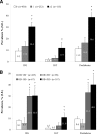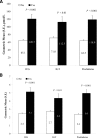Prevalence of pre-diabetes and its association with clustering of cardiometabolic risk factors and hyperinsulinemia among U.S. adolescents: National Health and Nutrition Examination Survey 2005-2006
- PMID: 18957533
- PMCID: PMC2628705
- DOI: 10.2337/dc08-1128
Prevalence of pre-diabetes and its association with clustering of cardiometabolic risk factors and hyperinsulinemia among U.S. adolescents: National Health and Nutrition Examination Survey 2005-2006
Abstract
Objective: Impaired fasting glucose (IFG) and/or impaired glucose tolerance (IGT) are considered to constitute "pre-diabetes." We estimated the prevalence of IFG, IGT, and pre-diabetes among U.S. adolescents using data from a nationally representative sample.
Research design and methods: We analyzed data from participants aged 12-19 years in the National Health and Nutrition Examination Survey 2005-2006. We used fasting plasma glucose and 2-h glucose during an oral glucose tolerance test to assess the prevalence of IFG, IGT, and pre-diabetes and used the log-binomial model to estimate the prevalence ratios (PRs) and 95% CIs.
Results: The unadjusted prevalences of IFG, IGT, and pre-diabetes were 13.1, 3.4, and 16.1%, respectively. Boys had a 2.4-fold higher prevalence of pre-diabetes than girls (95% CI 1.3-4.3). Non-Hispanic blacks had a lower rate than non-Hispanic whites (PR 0.6, 95% CI 0.4-0.9). Adolescents aged 16-19 years had a lower rate than those aged 12-15 years (0.6, 0.4-0.9). Overweight adolescents had a 2.6-fold higher rate than those with normal weight (1.3-5.1). Adolescents with two or more cardiometabolic risk factors had a 2.7-fold higher rate than those with none (1.5-4.8). Adolescents with hyperinsulinemia had a fourfold higher prevalence (2.2-7.4) than those without. Neither overweight nor number of cardiometabolic risk factors was significantly associated with pre-diabetes after adjustment for hyperinsulinemia.
Conclusions: Pre-diabetes was highly prevalent among adolescents. Hyperinsulinemia was independently associated with pre-diabetes and may account for the association of overweight and clustering of cardiometabolic risk factors with pre-diabetes.
Figures


References
-
- Barr EL, Zimmet PZ, Welborn TA, Jolley D, Magliano DJ, Dunstan DW, Cameron AJ, Dwyer T, Taylor HR, Tonkin AM, Wong TY, McNeil J, Shaw JE: Risk of cardiovascular and all-cause mortality in individuals with diabetes mellitus, impaired fasting glucose, and impaired glucose tolerance: the Australian Diabetes, Obesity, and Lifestyle Study (AusDiab). Circulation 116:151–157, 2007 - PubMed
-
- de VF, Dekker JM, Jager A, Hienkens E, Kostense PJ, Stehouwer CD, Nijpels G, Bouter LM, Heine RJ: Relation of impaired fasting and postload glucose with incident type 2 diabetes in a Dutch population: the Hoorn Study. JAMA 285:2109–2113, 2001 - PubMed
-
- Diagnosis and classification of diabetes mellitus. Diabetes Care 31(Suppl. 1):S55–S60, 2008 - PubMed
-
- Invitti C, Guzzaloni G, Gilardini L, Morabito F, Viberti G: Prevalence and concomitants of glucose intolerance in European obese children and adolescents. Diabetes Care 26:118–124, 2003 - PubMed
-
- Sinha R, Fisch G, Teague B, Tamborlane WV, Banyas B, Allen K, Savoye M, Rieger V, Taksali S, Barbetta G, Sherwin RS, Caprio S: Prevalence of impaired glucose tolerance among children and adolescents with marked obesity. N Engl J Med 346:802–810, 2002 - PubMed
MeSH terms
Substances
LinkOut - more resources
Full Text Sources
Medical
Research Materials

